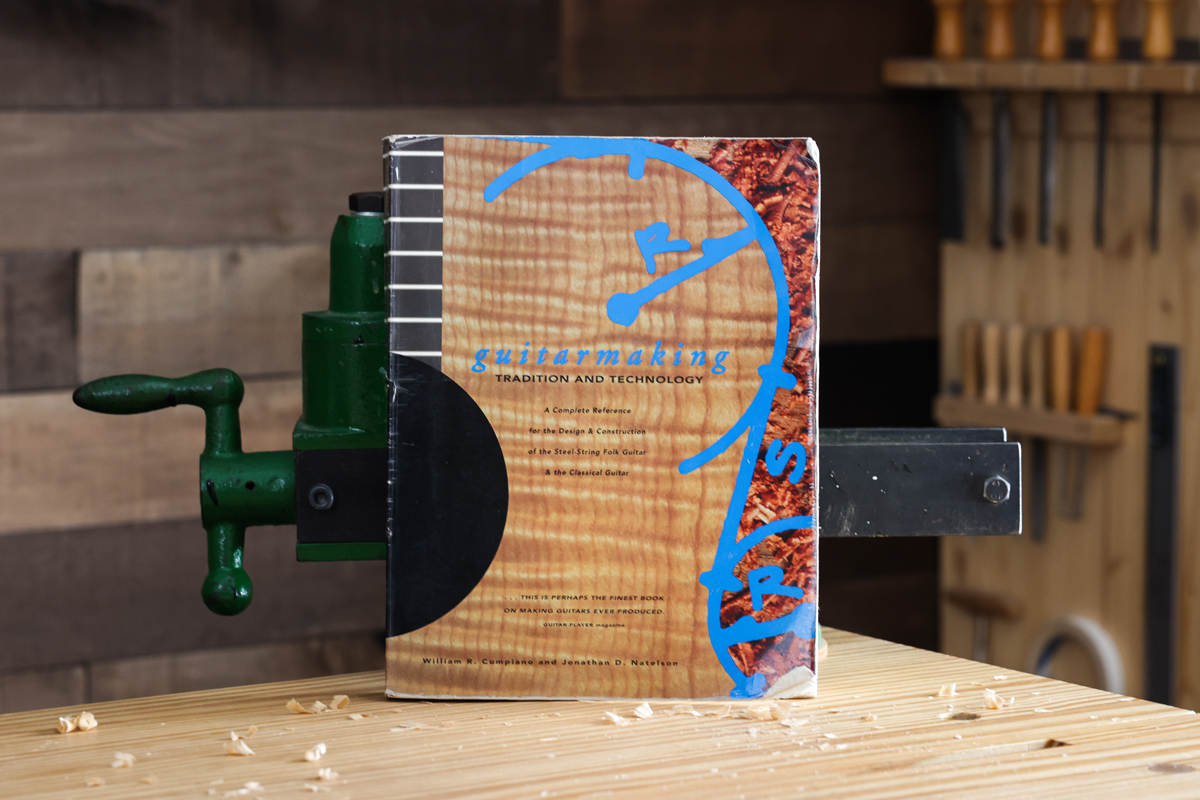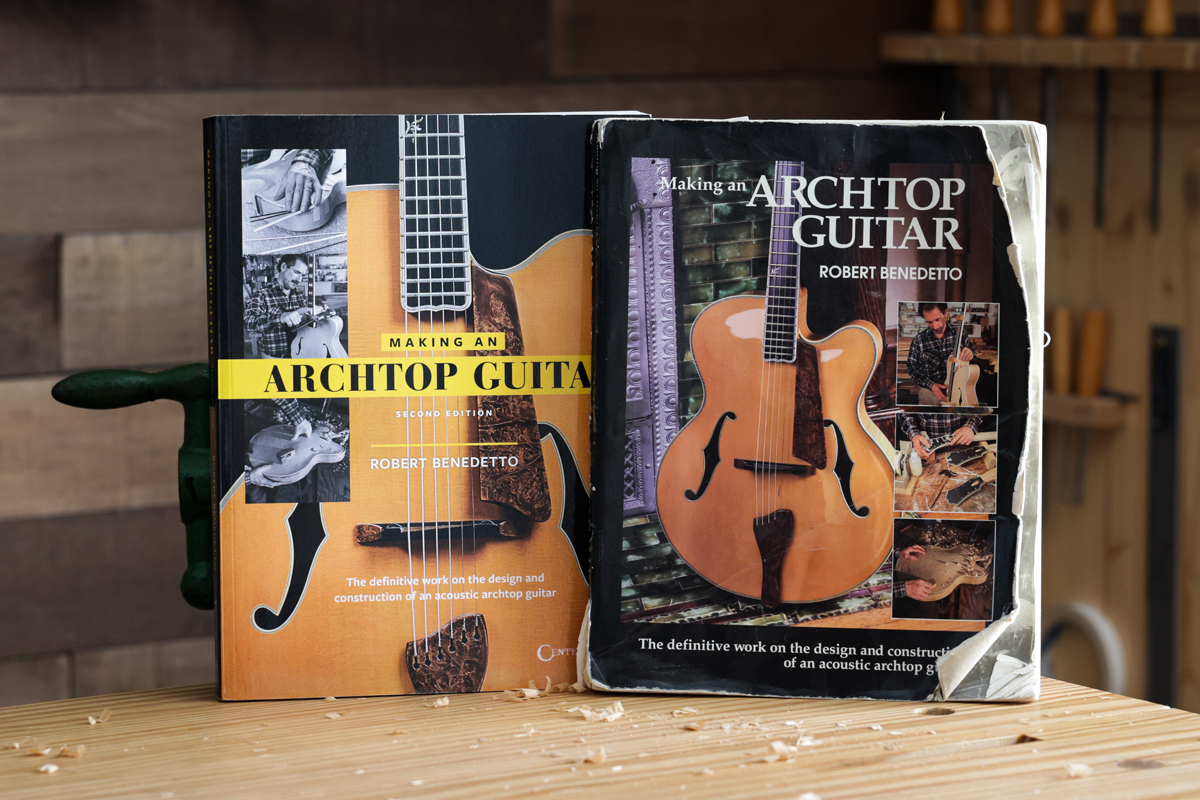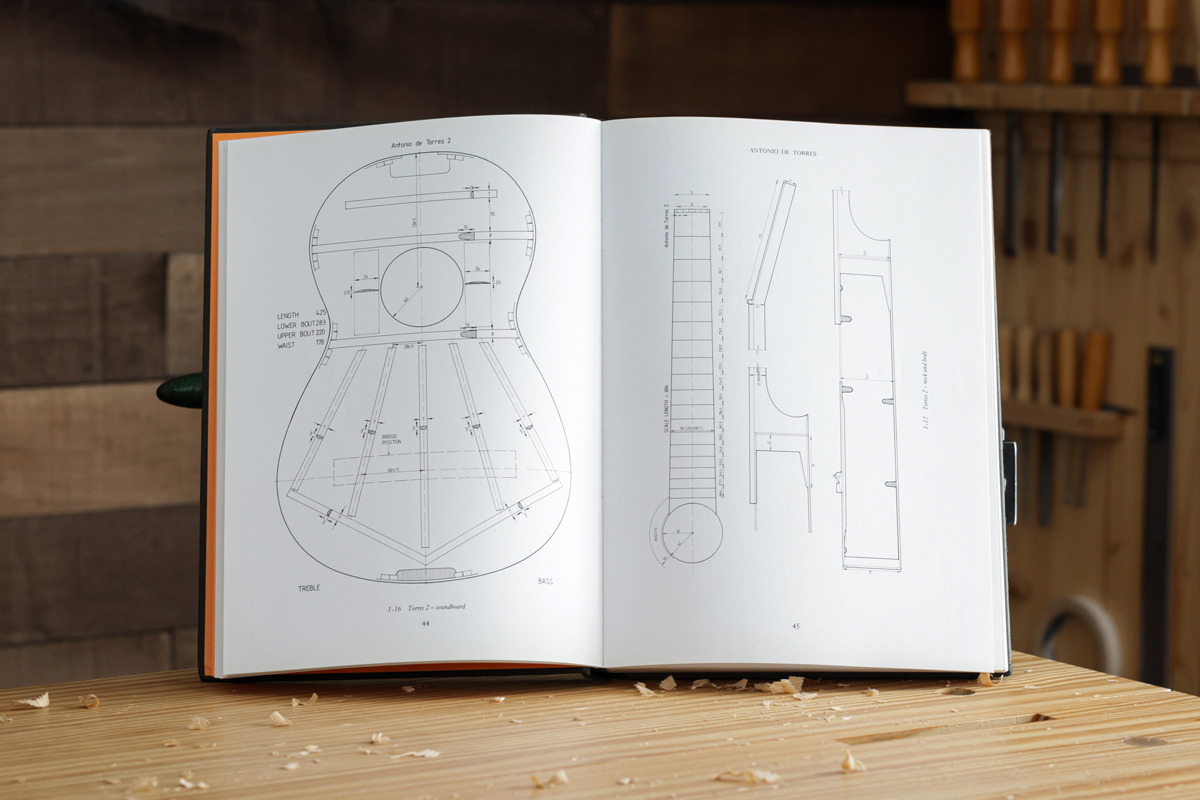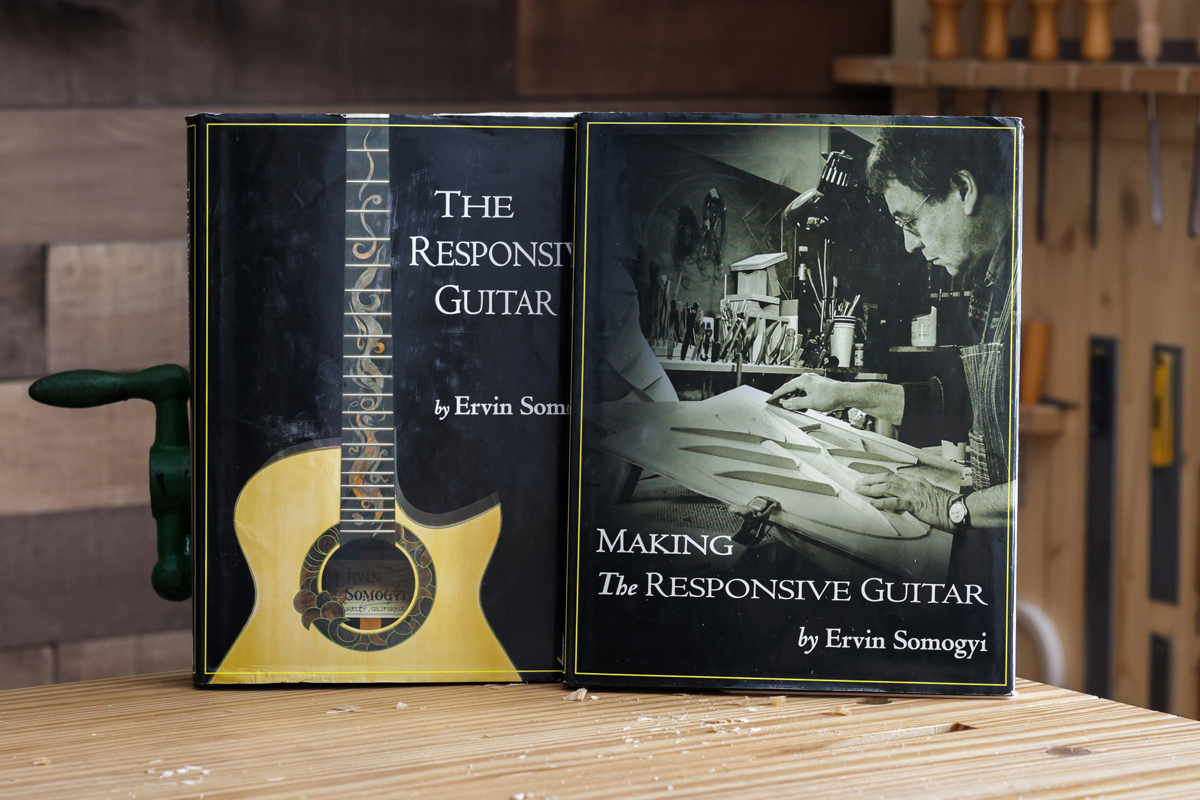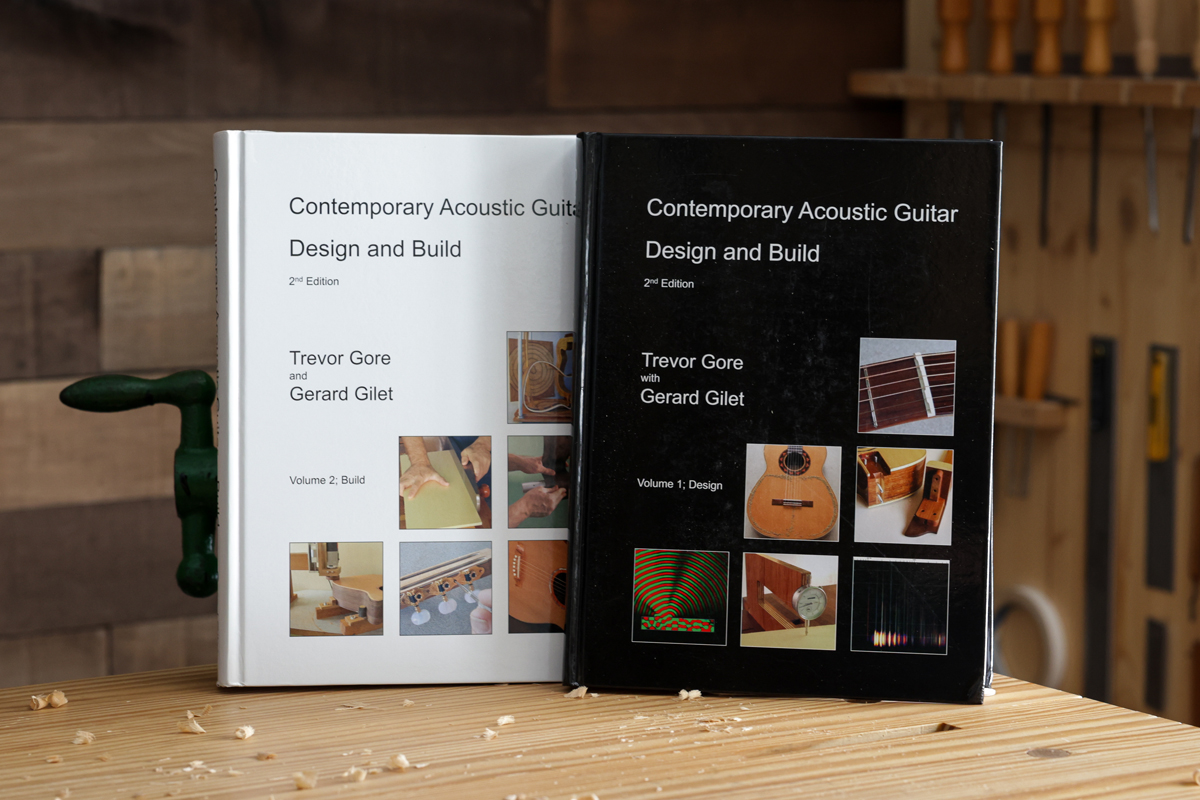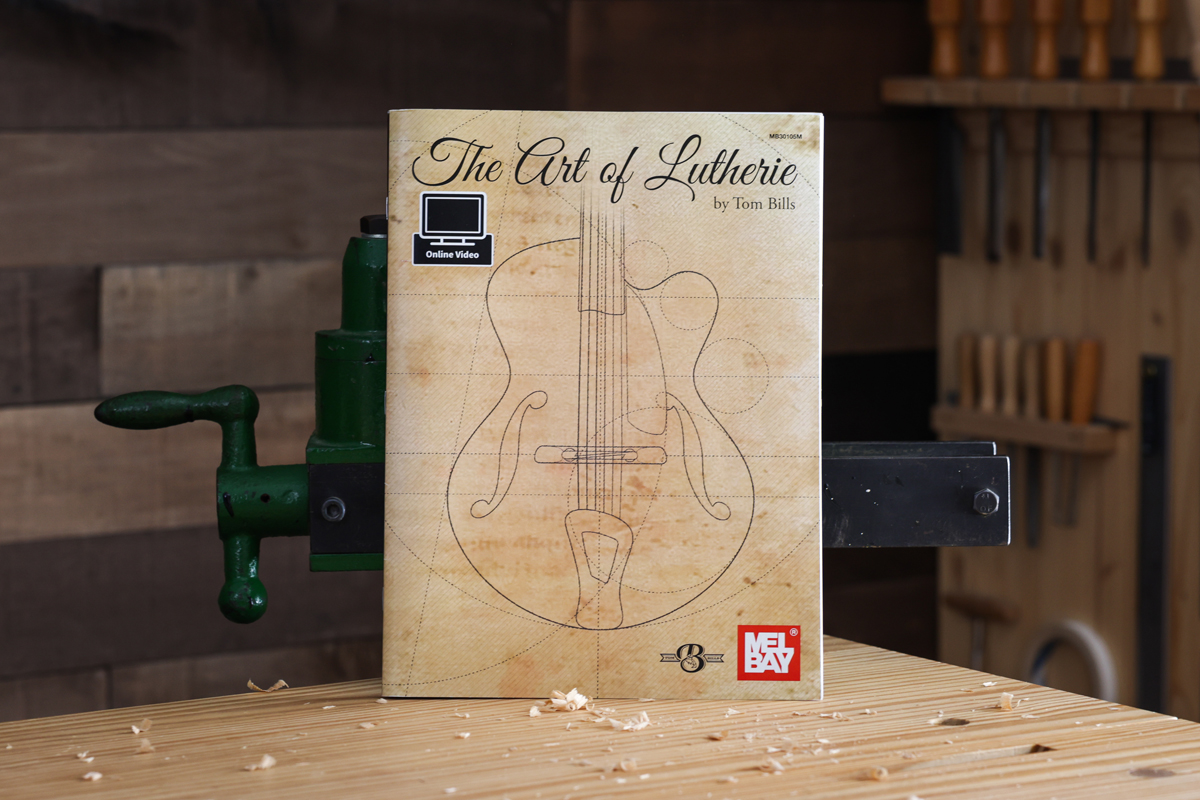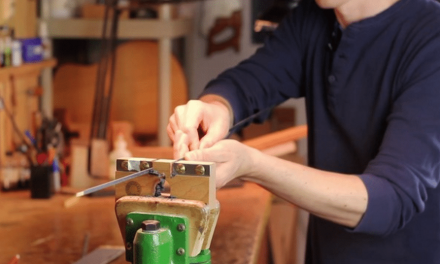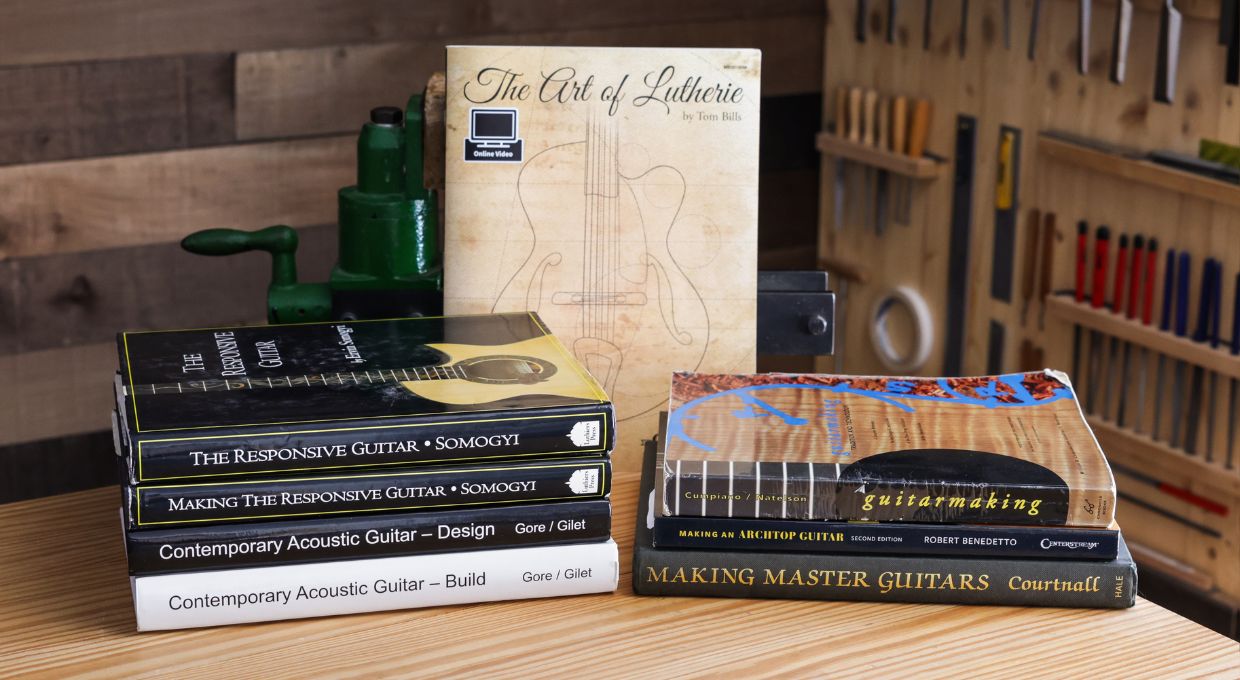
When I started making guitars in the ’90s, the options for guitar building books were pretty limited. Fast-forward to today and the landscape has completely changed—there are now so many books available that choosing the right one can feel a bit overwhelming.
That’s why, in this article, I’m sharing six guitar-building books that I personally own and wholeheartedly recommend.
The key to finding the best book, however, isn’t just about what’s popular; it’s about discovering the ones that:
- Align with your way of thinking
- Resonate with your learning style
- Meet you where you are on your lutherie journey.
To help you find the perfect fit and give you some context, I’ll share a little background about how I came across each book, how it shaped my growth as a luthier at the time, and how I still use them today to stay inspired, think creatively, and push myself to make each guitar better than the last.
There’s always more to learn, and embracing that never-ending journey is part of what makes the art of lutherie so fascinating, inspiring, and enjoyable and these foundational books are the perfect tools to fuel your creative and intellectual growth for many years to come.
Table Of Contents
1 – Guitar Making: Tradition & Technology
Guitar Making: Tradition & Technology was the first book I purchased on guitar building. At the time, I was earning my degrees in audio engineering and jazz guitar by day, playing acoustic concerts in coffee shops and events, and teaching guitar lessons at a local music shop in the evenings. Coming from a family of craftsmen, carpenters, and cabinet makers, the idea of building an acoustic guitar wasn’t entirely foreign to me, but it still felt like a big leap.
When I picked up this book, it immediately made the process feel approachable. The clear explanations and step-by-step instructions were exactly what I needed as a complete beginner. I spent months reading and rereading it, slowly building the confidence to give guitar making a try.
Of course, there were hurdles. When I asked a guitar tech at the shop where I taught lessons for advice, he dismissed the idea entirely, telling me it was too difficult and unlikely to succeed.
That setback almost extinguished my dream, but the knowledge I gained from this book kept the spark alive, even though it went dormant for a while.
What Makes This Book Special:
- Beginner-Friendly: The content is straightforward and accessible, making it perfect for someone new to lutherie.
- Comprehensive Reference: From standard measurements to setup tips, it’s a resource you can return to again and again.
- Minimal Tooling Required: The methods outlined require basic tools, making it ideal for those just starting.
If you’re looking for a book that provides a solid foundation in traditional guitar-making techniques, Guitar Making: Tradition & Technology is an excellent place to start.
2 – Making an Archtop Guitar
Bob Benedetto’s Making an Archtop Guitar is an essential resource for anyone interested in building archtop guitars. The book combines clear instructions, clear illustrations, and included templates, offering everything you need to embark on the fantastic journey of building an archtop guitar.
While studying jazz guitar in college, I was surrounded by classmates playing beautiful (and expensive) archtops while I made do with my humble Fender Strat. Feeling out of place and unable to afford a new guitar, I once again wondered if I could build one myself.
However, a chance encounter at a local music shop in 1998 led me to this book, and from the moment I opened it, I was captivated. By the time I finished reading it cover to cover in the bookstore that day, I knew I had to build my own guitar.
The combination of Bob’s guidance in this book and my growing determination ignited that old dormant spark into a passion that changed the course of my life and empowered me to build my very first guitar and take the first step into my new career. (Learn more about Bob Benedetto’s approach to archtop bracing in my article/mini interview here)
What Makes This Book Special:
- Expert Insights: Bob Benedetto’s decades of experience are distilled into approachable, actionable advice.
- Templates Included: The detailed drawings and templates are both practical and inspiring.
- Minimal Tooling: You can achieve great results without an elaborate workshop (relatively speaking).
This book, Making an Archtop Guitar, didn’t just teach me how to build an archtop—it gave me the confidence and courage to take the leap, and I will be forever grateful to Bob for sharing it.
3 – Making Master Guitars
The book Making Master Guitars, by Roy Courtnall is a treasure trove of classical guitar knowledge, offering a deep dive into the traditions and techniques that have shaped lutherie for centuries. It’s a beautifully crafted resource, complete with detailed drawings and historical context.
I discovered this book at the perfect time when I began exploring modern classical guitar designs in the early 2000s. While I was eager to innovate, I knew that grounding my work in tradition was essential. This book gave me access to a wealth of information about historically significant instruments, allowing me to study their design and incorporate those elements into my own instruments.
I still reference it often when I am working on new designs and when I am listening to historic guitars being played. I love to see the bracing patterns and other details as I listen; it’s become a sort of meditation practice that I love to do.
Learn more about this book and try listening to the playlist I put together of guitars from the book in my full article here.
What Makes This Book Special:
- Historical Context: Learn about the evolution of classical guitars and the master builders who shaped their design.
- Detailed Measurements: The book provides precise specs and illustrations that are invaluable for accurate recreations and experiments.
- Inspiration for Innovation: By understanding tradition, you’re better equipped to push the boundaries of your unique designs.
Whether you’re building your first classical guitar or refining your craft, Making Master Guitars offers insights that will deepen your appreciation for the history of the great master guitars of the past and pave the way for your own contribution to the long legacy of lutherie.
4 – The Responsive Guitar
Ervin Somogyi’s The Responsive Guitar is more than just a book—it’s a masterclass in understanding the guitar as a dynamic, living instrument. This comprehensive guide explores not only how to build guitars but also how to make them responsive, balanced, and musically rich.
I didn’t discover this set of books until much later in my career, but when I did, it felt like the missing pieces of a puzzle I had been working on for years. The book validated many of the ideas I had developed through experience while introducing new and fresh perspectives that challenged me to think more critically and creatively about my work.
What sets this book apart is its ability to inspire growth through different phases of the guitar-building journey. I often find myself returning to it when faced with a design challenge or seeking inspiration. Each time, I’m reminded of the endless possibilities within the craft and how much there still is to learn, regardless of how long we have been building or how many guitars we have made.
What Makes This Book Special:
- Blends Science and Art: Somogyi masterfully combines technical precision with artistic intuition, offering a holistic view of guitar building.
- Deep Exploration of Sound: The book dives into the physics of sound, helping you understand how design choices impact the instrument’s tone and playability.
- Invaluable for All Levels: Whether you’re a beginner or a seasoned luthier, the concepts are presented in an approachable and profoundly insightful way.
The Responsive Guitar is an essential resource if you want to take your guitar building to the next level. It can be a little overwhelming if you are just getting started, but it will help you understand the instrument on a deeper level, and it provides countless examples of jigs and methods to help you refine your building process and your guitars.
5 – Contemporary Acoustic Guitar Design and Build
If you love exploring the technical details and scientific principles behind guitar building, the two-volume set Contemporary Acoustic Guitar Design and Build, by Trevor Gore and Gerard Gilet is an absolute goldmine. Packed with in-depth insights, these books go far beyond the basics, delving into the frequencies, mechanics of sound, mathematical frameworks, and how your design choices directly influence a guitar’s performance.
While my natural inclination leans toward the creative, artistic, and intuitive aspects of guitar building, I’ve found these books to be invaluable for bridging the gap between intuition and science. They present complex, left-brain topics in a way that’s accessible and practical, offering a fresh perspective that complements my usual approach.
I’ve only recently added these books to my library and have been taking my time working through them—testing ideas, experimenting, and integrating some of their principles into my work. While I thrive on intuition and gut feeling as a “hippy artist type,” I also recognize the importance of measurable results in refining my craft and accelerating growth. These books have become my go-to reference when exploring new concepts or analyzing finished guitars in my workshop, and they’ve given me a new appreciation for the balance of art and science in lutherie.
What Makes These Books Special:
- Scientific Foudation: The books take a data-driven approach to guitar building, offering measurements, graphs, and detailed explanations that reveal the science behind how guitars work.
- Comprehensive Coverage: From materials selection to bracing patterns and even the acoustics of the finished instrument, these books leave no stone unturned.
- Practical Applications: Despite the depth of information, the books provide practical guidance that can be applied to real-world builds, helping you make informed decisions every step of the way.
If you are a person who loves to get deep into the numbers and the science of building guitars, Contemporary Acoustic Guitar Design and Build is a must-have for your guitar-making library. It also includes some fantastic blueprints, including one for a unique design by the author.
6 – The Art of Lutherie
If those books above seem too daunting and complex, and you’re searching for a resource to help you more easily understand the “why” behind what we do as luthiers, my book, The Art of Lutherie, is designed to be just that—an easy to understand guide to the foundational principles that shape every part of the process.
This isn’t just another instruction manual or technical deep dive; it’s a tool to complement the other guitar building books you might already have, helping you connect the dots and deepen your understanding in a way that’s approachable, practical, and easy to apply.
One of the best ways to use this book is alongside the other guitar-building resources I listed. While those books provide incredible depth, The Art of Lutherie simplifies and distills key principles, giving you a solid foundation to make those advanced concepts easier to grasp and apply. My goal is to provide a companion resource for you when you need clarity—whether you’re learning something new or revisiting a tricky concept.
What Makes This Book Special:
- Foundational Focus: It’s not just about how to build a guitar—it’s about understanding the principles behind every decision so you can build with intention and confidence, and find your own style and voice.
- Practical and Accessible: Complex ideas are broken down into clear, straightforward explanations, making them easy to understand, no matter your level of experience.
- A Resource for All Levels: Whether you’re just starting your journey or looking to take your craft to the next level, this book is designed to grow with you.
Understanding the “why” behind what we do isn’t just helpful—it’s transformative. It’s what allows you to step beyond formulas and recipes and truly create something that’s your own.
My hope is that The Art of Lutherie book becomes a trusted resource on your workbench, helping you find clarity, creativity, and confidence as you grow as a luthier.
What if you have the books, but you still feel stuck?
While guitar building books are invaluable resources, there are still many times when personal guidance can make all the difference. It was for me when I was struggling to grow as a luthier.
After personally helping thousands of students in the Luthier’s EDGE, I can tell you firsthand that having an experienced luthier to ask questions and help you directly is the key to helping you integrate the knowledge you gain from books and courses into your work, make them your own, and push past the limits that were holding you back.
I love helping each student, answering questions, and helping to solve problems, ensuring you deeply understand the concepts and techniques and can apply them confidently and effectively.
If you could use a little boost to help you get started or to reach higher levels of confidence or quality in your work, check out the Luthier’s EDGE and see if it’s a good fit for you.
And, if you have any questions, please don’t hesitate to reach out and let me know.
Remember, the journey of learning the art of lutherie never ends. Stay curious, keep learning, and do your best to enjoy every step of the process.

